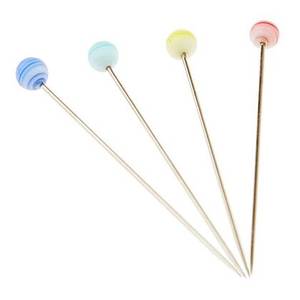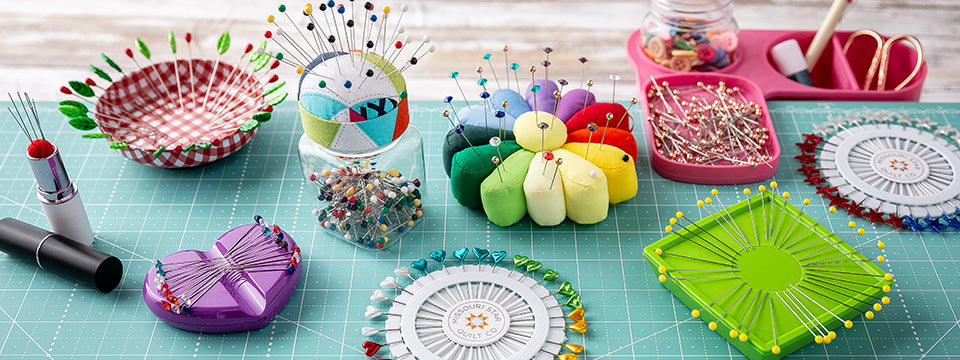

Sewing Pins & Needles
Sharp quilting & sewing pins are a must to keep your projects together! Browse a variety hand quilting needles, sewing machine needles, & cute sewing pins. Store quilt pins & needles in a decorative pin cushion, pin caddy or magnetic pin holder. Get quilting faster with needle threaders & don't forget a thimble to prote... read more
Sewing Pins & Needles
“Needle” little guidance on choosing the correct sewing needle for your next project? No need to be on pins & needles....we’re here to help!
Sewing Pins vs. Quilting Pins
Sewing pins are small, slender, pointed tools typically made of metal with a colored plastic or glass head. Quilting pins are a type of sewing pin specifically designed for quilting projects.
While they share similarities with traditional sewing pins, quilters pins are tailored to the unique demands of quilting projects, providing the necessary strength, sharpness, and ease of use required for securely holding together the layers of a quilt during the quilting process. Both kinds of fabric pins come in various lengths and thicknesses, with longer pins often used for thicker fabrics and shorter pins for finer fabrics.
What are the best quilting pins?
The answer to this question will depend on two factors: personal preference, and how you want to use them. We have quilting pins that are numbered to keep your blocks organized; fab ric pins with smaller, glass heads that are heat safe; and fan favorite Magic Pins, which are thinner and can be ironed over. They’re perfect for applique projects!
As you’re sewing, you’ll want to use quilting pins to keep your quilt squares in place for neat and tidy seams. A few pins go a long way!
What are basting pins?
When you’re finished sewing your quilt top and it’s time to make your quilt sandwich, there are special quilting pins to use that are known as basting pins. They are like regular safety pins except they have a bend in them to make basting a cinch! Because basting pins are curved, they come up through the layers of a quilt easily. If you’re wondering what size curved safety pins for quilting are typically used they are usually size 2, which is 1 ½” inches long. They hold your quilt sandwich together throughout the quilting process to ensure a smooth finish.
Sewing Needles vs. Quilting Needles
Sewing needles are long, slender tools with a pointed tip at one end and a hole, called an eye, at the other end through which thread is passed. They are used to hand sew fabrics together or for various needlework techniques such as embroidery, cross-stitch, and needlepoint. Sewing needles come in different sizes and types, each suited for specific fabrics and stitching techniques. They may have sharp or blunt points depending on the type of fabric being sewn and the desired effect.
Quilting needles, like quilting pins, are specifically designed for the unique requirements of quilting projects. While they share similarities with standard sewing needles, there are some notable differences. First, quilting needles are often slightly longer and thicker than regular sewing needles. The eye of a quilting needle is also larger and elongated compared to that of a standard sewing needle. Quilting needles come in various types to accommodate different quilting techniques, and you may encounter some that have specialized features such as a tapered point or a slightly curved shape to aid in smoother stitching and reduce hand fatigue during prolonged quilting sessions.
If you’re not sure about the difference between a ballpoint needle and a universal needle, we’re here to POINT you in the right direction! The main difference between a ballpoint needle and a universal needle is their tip design and the type of fabric they are best suited for. Ballpoint needles are designed specifically for knit fabrics to prevent damage, while universal needles are more versatile and suitable for a broader range of fabric types, both woven and knit.
When should I change my sewing needle?
Did you know that you should change your sewing needle after 8 total hours of sewing? That means, with every new project, it’s probably time to change out your needle. After many hours of puncturing the fabric, the needle quickly becomes dull and causes problems with stitch quality. When in doubt, get a new set of quilting needles. It may solve your problem!

What size needle is best for piecing a quilt?
The type of fabric and the thread you are sewing with determines the needle size. For quilting cotton, you’re going to want to use a sharp quilting needle somewhere between a size 11-14, depending on the thickness of the thread. We recommend using 50wt thread for piecing. The two numbers you see side by side on the package of needles are actually the same size, but they are either Imperial or Metric. For example, sewing needles that are size 11 Imperial are also size 75 in Metric sizing.
For fabrics with stretch like spandex, lycra, or anything knit, be sure to use a ballpoint needle. Not to be confused with universal needles, ballpoints have rounded edges and do not come to a sharp point. They’re designed to push aside individual thread strands of the fabric without breaking through the weave. So be sure to switch out your needle when changing between quilting cottons and knits.
Finally, keep your quilting notions in order with a nifty sewing pin holder or a pin cushion. There are so many awesome magnetic pin holders, pin dishes, caddies, and more to make sure your sewing tools have a place to be in your sewing room. From the traditional tomato pin cushion to super strong Zirkel and Grabbit magnetic pin cushions, they’re just what you need to keep your quilt tools safe and sound.
Watch the video below to learn all about pins and needles with Misty!
Both sewing pins and needles are indispensable tools for anyone engaged in sewing or needlework, whether for practical purposes such as garment construction or for creative endeavors like crafting and embellishment. The right quilting supplies can make all the difference! Who knew?















































































































































































































































































